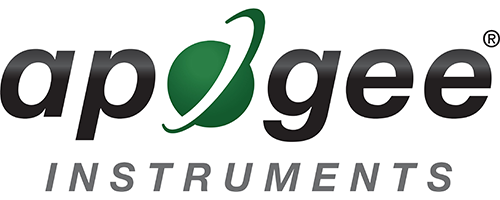
警报
如果您的SQ-420传感器的序列号小于1258点击这里更新说明。
常见问题解答
Select product for product FAQs
重新校准和维修
Apogee重新校准哪些传感器?
重新校准传感器的成本是多少?
我应该多久重新校准我的传感器?
For maximum accuracy, we generally recommend all sensors be recalibrated every two years. You may wish to wait longer between recalibration cycles depending on your requirements. The Clear Sky Calculator may be used as a quick reference to determine if recalibration is necessary for pyranometers and quantum sensors, click here for more information on the
清晰的天空计算器。
如何发送我的传感器/仪表进行维修?
如何知道我的太阳辐射传感器是否需要重新校准?
重新校准传感器的频率随着应用而变化很大。通常,我们建议每两到三年的重新校准周期,特别是在使用连续户外应用中的传感器时。但是不是猜测,还有另一种方法允许最终用户进行确定。该
清晰的天空计算器is designed to calculate the intensity of radiation falling on a horizontal surface, at any time of day, in any location in the world. Essentially, the calculator outputs an estimated value that can be directly compared to the output of the sensor(s) in question. For best accuracy, comparison should be made on clear, non- polluted, summer days within one hour of solar noon. The test sensor(s) should also be leveled and cleaned to help produce consistent measurements.
我应该多久应重新校准我的红外辐射计传感器?
We recommend recalibration every two years. For information on recalibrating your infrared radiometer
点击这里。
单位转换
ppf的转换是什么(μmolm-2S.-1)到其他单位?
General Information
apogee如何获得规范信息?
在Apogee,我们的太阳辐射传感器具有精度(5%),均匀性(3%)和重复性(1%)的规范。精度将每个传感器的输出与绝对参考标准进行比较。均匀性是我们的传感器彼此比较的一致性。重复性是指传感器如何对自身执行。相同的传感器是否在相同的条件下始终如一地执行?我们规范中的数字基于统计分析。将传感器的大群体与可用的参考,ISO或NIST进行比较,并测量错误。然后,我们从参考标准计算样品的平均值和标准偏差。列出的规格,用于精度,均匀性和可重复性,代表了与平均值(95%的人口)的两个标准偏差。欲获得更多信息,
点击这里对于传感器规范的知识库文章。
什么是光合辐射,为什么要测量以预测植物生长?
Photosynthesis and plant growth depend on the energy in radiation, but only specific wavelengths of radiation cause photosynthesis. We have known since Einstein that one photon excites one electron (the Stark-Einstein Law), which starts photosynthesis. In 1972 a scientist named Keith McCree showed that a meter that counted the number of photons in radiation would more accurately predict photosynthesis than the previously used foot-candle meters. LI-COR (Lincoln, NE) started making meters to measure this radiation and scientists quickly switched to the new measurement system, which is called Photosynthetic Photon Flux (PPF). The energy in a photon is called a quantum so these meters are called quantum meters. A quarter century later, LI-COR has sold thousands of high quality meters, but their least expensive quantum meter with sensor costs $780. The high cost means that they are used only by scientists and large commercial growers. Smaller growers have continued to use foot-candle meters, which measure light for humans. Footcandle meters have errors of up to 45% when used to measure light for photosynthesis.
What are some properties of solar radiation?
太阳辐射是用于描述从太阳发出的可见和接近可见(紫外线和近红外)辐射的术语。不同区域由它们的波长范围在200至100000nm(纳米)的宽带范围内。
陆地辐射是用于描述从地球发出的红外辐射的术语。太阳能和地面辐射的组件及其波长范围是:
| 紫外线 |
250到400 nm |
UV传感器或光谱放射性计 |
| 可见 |
400到700 nm |
Quantum sensor or spectroradiometer |
| 近红外 |
700 to 3000 nm |
|
| 红外线 |
3000到100 000 nm |
红外辐射计 |
大约99%的太阳能或短波,地球表面的辐射含量在300至3000nm的区域中包含,而大多数陆地或长波,辐射包含在3500至50 000nm的区域中。
Outside the earth's atmosphere, solar radiation has an intensity of approximately 1370 watts per square meter. This is the value at mean earth-sun distance at the top of the atmosphere and is referred to as the Solar Constant. On the surface of the earth on a clear day, at noon, the direct beam radiation will be approximately 1000 watts per square meter for many locations.
能量是影响位置的可用性(including latitude and elevation), season, and time of day. All of which can be readily determined. However, the biggest factors affecting the available energy are cloud cover and other meteorological conditions, which vary with location and time.
从历史上看,在完整的日子里,已经使用水平仪器进行了太阳能测量。在美国北部,这导致初夏价值超过早期冬季值的4至6倍。在南方,差异将是2至3倍。这部分是由于天气和较大程度,太阳角和日光的长度。
![]()
